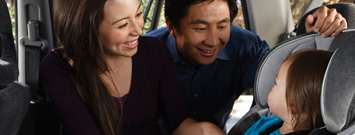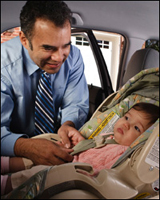Child Passenger Safety
 Make sure the ones you love are safe and secure in the car—all the time, on every trip.
Make sure the ones you love are safe and secure in the car—all the time, on every trip.
Reduce Their Risk

Learn all you can do to keep your most precious cargo safe and locate a car seat inspection station in your area.
In 2009, 1,314 children ages 14 years and younger died in motor vehicle crashes, and approximately 179,000 were injured. But parents and caregivers can make a lifesaving difference.
Whenever you're on the road, make sure your child passengers are buckled into appropriate safety seats. The safest place for children of any age to ride is properly restrained in the back seat. Data show that:
- In 2010, restraint use saved the lives of 303 children ages 4 and younger. Child safety seats reduce the risk of death in car crashes by 71% for infants and 54% for toddlers ages one to four.
- For children ages 4 to 7, booster seats reduce injury risk by 59% compared to safety belts alone.
All children younger than 13 years should ride in the back seat. Airbags can kill young children riding in the front seat. Never place a rear-facing car seat in the front seat or in front of an air bag.
Know the Stages

In an effort to raise parents' awareness about the leading causes of child injury in the United States and how they can be prevented, CDC launched the "Protect the Ones You Love" initiative. Parents can play a life-saving role in protecting children from injuries. Information is available in English and Spanish. Learn more.
- Birth through Age 2 – Rear-facing child safety seat. For the best possible protection, infants and children should be kept in a rear-facing child safety seat, in the back seat buckled with the seat’s harness, until they reach the upper weight or height limits of their particular seat. The weight and height limits on rear-facing child safety seats can accommodate most children through age 2, check the seat’s owner’s manual for details.
- Between Ages 2-4/Until 40 lbs – Forward-facing child safety seat. When children outgrow their rear-facing seats (the weight and height limits on rear-facing car seats can accommodate most children through age 2) they should ride in forward-facing child safety seats, in the back seat buckled with the seat’s harness, until they reach the upper weight or height limit of their particular seat (usually around age 4 and 40 pounds; many newer seats have higher weight limits-check the seat’s owner’s manual for details).
- Between Ages 4-8 OR Until 4'9" Tall – Booster seat. Once children outgrow their forward-facing seats (by reaching the upper height and weight limits of their seat), they should ride in belt positioning booster seats. Remember to keep children in the back seat for the best possible protection.
- After Age 8 AND/OR 4'9" Tall – Seat belts. Children should use booster seats until adult seat belts fit them properly. Seat belts fit properly when the lap belt lays across the upper thighs (not the stomach) and the shoulder belt fits across the chest (not the neck). When adult seat belts fit children properly they can use the adult seat belts without booster seats. For the best possible protection keep children in the back seat and use lap-and-shoulder belts.
Remember: All children younger than 13 years should ride in the back seat. Never place a child in the front seat facing an airbag.
CDC's online fact sheets on child passenger safety and road traffic injury prevention can help you learn more.
More Information
- Child Passenger Safety: Information and Resources
- Protect the Ones You Love: Road Traffic Injuries
- Task Force on Community Preventive Services and the Community Guide: Motor Vehicle Occupant Safety
- CDC National Action Plan for Child Injury Prevention
- CDC Childhood Injury Report
- National Highway Traffic Safety Administration: Child Passenger Safety Week
Podcasts on Child Passenger Safety
- Are We There Yet?: A Cup of Health with CDC [PODCAST - 3:52 minutes] (2008)
- Staying Safe on the Road [PODCAST - 4:55 minutes] (2008)
- Buckle 'em Up: A Minute of Health with CDC [PODCAST - 0:59 minutes] (2009)
- Buckle 'em Up: A Cup of Health with CDC [PODCAST - 3:56 minutes] (2009)
- Restrain Your Children: Minute of Health with CDC [PODCAST - 0:59 minutes] (2011)
- Restrain Your Children: Cup of Health with CDC [PODCAST - 5:19 minutes] (2011)
CDC works 24/7 saving lives and protecting people from health threats to have a more secure nation. A US federal agency, CDC helps make the healthy choice the easy choice by putting science and prevention into action. CDC works to help people live longer, healthier and more productive lives.
Get email updates
To receive email updates about this page, enter your email address:
Contact Us:
- Centers for Disease Control and Prevention
1600 Clifton Rd
Atlanta, GA 30333 - 800-CDC-INFO
(800-232-4636)
TTY: (888) 232-6348 - cdcinfo@cdc.gov



